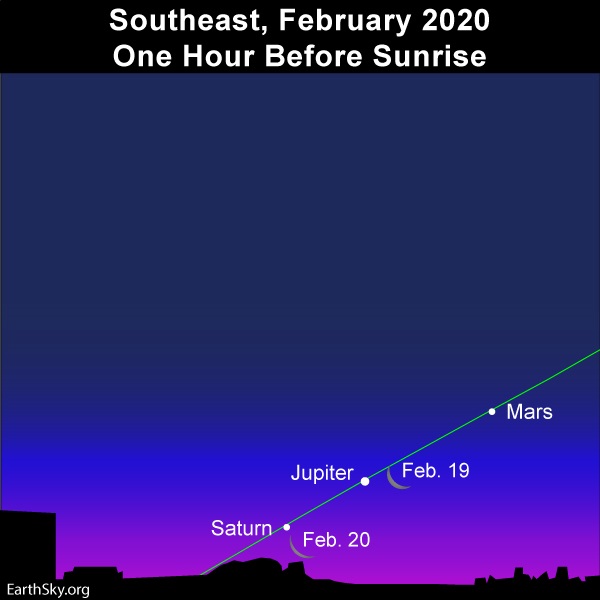Looking for information on the February 18, 2020, occultation of Mars by the moon? Click here.
Before sunrise on February 16 and 17, 2020, look for the lit side of the waning crescent moon to point to a string of planets in the early morning sky. From top to bottom, these planets are Mars, Jupiter and Saturn. The moon rises first, followed by the red planet Mars, then the king planet Jupiter and then the ringed planet Saturn shortly before sunup. The bright reddish light close to the moon on the morning of February 16 is Antares, Heart of the Scorpion in the constellation Scorpius.
IMPORTANT: You might have to get up before dawn (~90 minutes before sunrise) to view the planet Mars and the star Antares. By the time that Saturn rises in the morning twilight, Mars and Antares may have faded or nearly faded from view. The moon and Jupiter will likely still be visible at dawn, so you can draw a line from the moon and past Jupiter to seek for Saturn near the sunrise point on the horizon. An unobstructed horizon in the direction of sunrise will help. Binoculars will also come in handy!
We give the approximate rising time for Saturn at various latitudes:
60 degrees north latitude
Saturn rises 2/3 hour before sunrise40 degrees north latitude
Saturn rises 1 1/2 hours before sunriseEquator (0 degrees latitude)
Saturn rises 2 hours before sunrise35 degrees south latitude
Saturn rises 2 2/5 hours before sunriseWant more specific information? Find out when the planets rise in your sky at TimeandDate
The illuminated side of the moon is the moon’s daylight side, whereas the dark side is its nighttime side. The lunar terminator – the shadow line dividing the lunar day from the lunar night – shows you where it’s sunset on the waning moon. It’s along the terminator that you get your best three-dimensional views of the lunar terrain with an optical aid.

The lit side of the waning moon always points eastward, or in the moon’s direction of travel in front of the constellations of the zodiac. It takes the moon some 27.3 days to go full circle through the zodiac, a time period that astronomers call the sidereal month. Because the moon’s illuminated side is now pointing at these morning planets, we can anticipate the waning crescent moon going by them in the near future. The moon will swing by Mars on February 18, Jupiter on February 19 and Saturn on February 20.
Want to know which constellation of the zodiac presently backdrops the moon? Click on Heavens-Above to find out.
In fact, if you’re at just the right spot on the globe, you can actually watch the moon occult (pass in front of) Mars on February 18 and Jupiter on February 19. We tell you more about these occultations on our February 17 Tonight post. The moon won’t occult Saturn, however, because it’ll pass to the south of the ringed planet.
Bottom line: Get up early on February 16 and 17, 2020, and let the waning crescent moon point out a parade of three bright planets adorning the east before sunup.
Watch Mars disappear behind the moon on Tuesday morning, February 18, 2020











